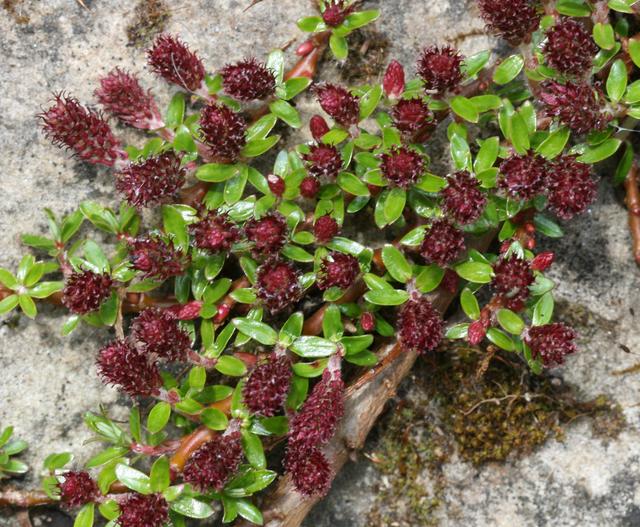Dwarf Willow
(Salix fruticulosa)
Dwarf Willow (Salix fruticulosa)
/
/

S. Rae
CC BY 2.0
Image By:
S. Rae
Recorded By:
Copyright:
CC BY 2.0
Copyright Notice:
Photo by: S. Rae | License Type: CC BY 2.0 | License URL: https://creativecommons.org/licenses/by/2.0 | Uploader: Josve05a | Publisher: Wikipedia Commons



Estimated Native Range
Summary
Salix fruticulosa, commonly known as Dwarf Willow, is a deciduous shrub native to the montane and subalpine zones of the eastern Himalayas, including Nepal and Tibet, where it thrives in moist areas, often near streams and rivers, within silver fir–birch forests at elevations of 9,200 to 12,500 feet. This species typically grows to a modest height of 1-2 feet (0.3-0.6 meters) with a similar spread, forming dense, low clumps. The Dwarf Willow is characterized by its small, narrow leaves and inconspicuous yellow or green catkins that appear in early spring before the leaves emerge. While the flowers are not particularly showy, they are of ecological importance as they provide an early source of pollen and nectar for insects.
Dwarf Willow is valued for its ability to grow in challenging high-altitude environments and is sometimes used in rock gardens or as ground cover in alpine and subalpine garden settings. It requires moist, well-drained soils and can tolerate partial shade, although it prefers full sun. Due to its small size and slow growth rate, it is low-maintenance and can be a good choice for small gardens. However, it may be susceptible to willow scab and other fungal diseases. Gardeners should be aware that willows can have aggressive roots, so planting near plumbing or structures should be avoided.CC BY-SA 4.0
Dwarf Willow is valued for its ability to grow in challenging high-altitude environments and is sometimes used in rock gardens or as ground cover in alpine and subalpine garden settings. It requires moist, well-drained soils and can tolerate partial shade, although it prefers full sun. Due to its small size and slow growth rate, it is low-maintenance and can be a good choice for small gardens. However, it may be susceptible to willow scab and other fungal diseases. Gardeners should be aware that willows can have aggressive roots, so planting near plumbing or structures should be avoided.CC BY-SA 4.0
Plant Description
- Plant Type: Shrub
- Height: 1-3 feet
- Width: 1-3 feet
- Growth Rate: Moderate
- Flower Color: N/A
- Flowering Season: Spring
- Leaf Retention: Deciduous
Growth Requirements
- Sun: Full Sun, Part Shade
- Water: High
- Drainage: Medium, Slow
Common Uses
Bird Garden, Low Maintenance, Water Garden
Natural Habitat
Montane and subalpine zones within silver fir–birch forests
Other Names
Common Names: Shrub Willow
Scientific Names: , Salix fruticulosa, Salix brachista var. multiflora, Salix chumulamanica, Salix furcata, Salix hylematica, Salix hylematica var. scopulicola, Salix longipes, Salix longipes, Salix nelamunensis
GBIF Accepted Name: